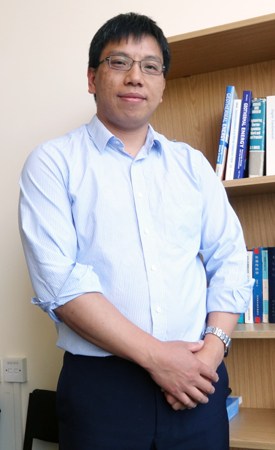Academic with a hard hat
Published: 6 June 2016
A remarkable relationship between a Gilmorehill academic and the construction team that installed the University's district heating scheme is being hailed a success and model for industry engagement.
A remarkable relationship between a Gilmorehill academic and the construction team that installed the University's district heating scheme is being hailed a success and a model for industry engagement.
 Dr Zhibin Yu, a Lecturer in Energy Engineering in the School of Engineering, spent a year working on a placement with Crown House Technologies, the main contractor for the district heating scheme. Zhibin's role was born during the very early stages of the project in 2014. An informal grouping of academics from the School of Engineering were exploring the potential teaching/learning/research benefits from this large project. The concept of a part-time secondment was then recommended to the Project Board. The proposal was accepted by the Board and Dr Zhibin Yu was offered a placement with the project design team, working with Crown House Technology for an average of one day per week.
Dr Zhibin Yu, a Lecturer in Energy Engineering in the School of Engineering, spent a year working on a placement with Crown House Technologies, the main contractor for the district heating scheme. Zhibin's role was born during the very early stages of the project in 2014. An informal grouping of academics from the School of Engineering were exploring the potential teaching/learning/research benefits from this large project. The concept of a part-time secondment was then recommended to the Project Board. The proposal was accepted by the Board and Dr Zhibin Yu was offered a placement with the project design team, working with Crown House Technology for an average of one day per week.
Zhibin's primary objective was to identify the potential teaching/learning/research benefits, and assist the design team to embed such functionalities in the final design of the system. A secondary objective was to maximise the teaching and learning benefits during the actual installation period of the CHP system.
Savings
The district heating scheme is now complete. The massive combined heat and power engine at its heart is now delivering heat AND electricity for the Gilmorehill campus. The University is now cutting its carbon emissions by 5000 tonnes annually. It has also moved much closer to the target of a 20% reduction in its carbon footprint.
Zhibin is wiping a metaphorical brow, as his placement required a skilful juggling of his teaching and research commitments. He says: "I didn't quite realise at first just how important the time spent on the project would be for me.
"I knew there would be benefits, because industry placements or secondments are a very important part of an academic CV. Not everyone can have this and it is potentially very beneficial. I certainly was hoping to get some good ideas from the experience about teaching our students and perhaps also some beneficial dividends for my research.
"What I didn't appreciate at first was how useful it would be to engage with construction industry and energy industry professionals and to experience how they work on a major project, such as the district heating scheme. It's so different!"
Zhibin says much of what he has learned has come from comparing methodologies in the academic world with those in industry. This is to do with the way engineering/construction professionals can take a design that is ideal from a research and academic point of view, and shape it to also account for cost-effectiveness, safety and back-up capacity in the case of main-system failure.
Therma Pump
Zhibin's activities during his placement covered many areas: attending project meetings; communicating the nature of the project to fellow academics and to students; identifying potential learning, teaching and research benefits; engaging with the design team to look for additional system benefits. One lasting benefit for the University is a permanent viewing and teaching space adjacent to the CHP engine itself, deep under the chimney stack by the Davidson building.
"During this secondment, I learned the real industrial challenges in the heating sector, which inspired me to develop a concept of integrating a CHP engine with a heat pump system to develop a novel low-carbon heating technology. This has now resulted in a major programme research grant from the Engineering and Physical Sciences Research Council (EPSRC) - Therma-Pump - valued at £713,033.
Despite the pressures generated by the additional workload, Zhibin is upbeat about the experience of his industry placement: "This is the first time I have worked directly with industrialists in a real industrial project at large scale. I have gained precious experience and knowledge that will be very important for my teaching and research in the future. It was also very enjoyable!"
Paul Younger, the Rankine Chair of Engineering and Professor of Energy Engineering served on the project for the University’s CHP project. He said: "Zhibin’s placement on the University’s Combined Heat and Power project ensured that academic input to the system design was fully realised. This was, in effect, the first concrete case of an academic helping to turn the campus into a research lab. This is the core notion of the Smart Campus concept. The practical experience that Zhibin gained is already paying dividends more widely as he takes up the role of Research Theme Coordinator for Heat within the Scotland-wide Energy Technology Partnership programme".
Links
District Heating Scheme - The Movie
First published: 6 June 2016
<< June

